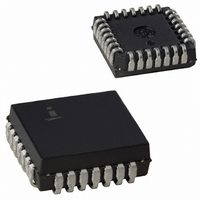CS82C5296 Intersil, CS82C5296 Datasheet - Page 3

CS82C5296
Manufacturer Part Number
CS82C5296
Description
IC UART/BRG 5V 16MHZ 28-PLCC
Manufacturer
Intersil
Datasheet
1.IS82C52Z.pdf
(20 pages)
Specifications of CS82C5296
Features
Single Chip UART/BRG
Number Of Channels
1, UART
Protocol
RS232C
Voltage - Supply
4.5 V ~ 5.5 V
With Parallel Port
Yes
With False Start Bit Detection
Yes
With Modem Control
Yes
With Cmos
Yes
Mounting Type
Surface Mount
Package / Case
28-LCC (J-Lead)
Lead Free Status / RoHS Status
Contains lead / RoHS non-compliant
Fifo's
-
With Auto Flow Control
-
With Irda Encoder/decoder
-
Available stocks
Company
Part Number
Manufacturer
Quantity
Price
Pin Description
SYMBOL
D0-D7
A0, A1
IX, OX
TBRE
INTR
SDO
GND
DSR
DTR
CTS
RTS
RST
WR
RD
CO
11, 12
13, 14
3-10
NO.
PIN
15
16
17
18
19
20
21
22
23
24
1
2
TYPE
I/O
I/O
O
O
O
O
O
O
I
I
I
I
I
I
3
ACTIVE
LEVEL
High
High
High
High
High
High
Low
Low
Low
Low
Low
Low
Low
READ: The RD input causes the 82C52 to output data to the data bus (D0-D7). The data output
depends upon the state of the address inputs (A0-A1). CS0 enables the RD input.
WRITE: The WR input causes data from the data bus (D0-D7) to be input to the 82C52. Addressing
and chip select action is the same as for read operations.
DATA BITS 0-7: The Data Bus provides eight, three-state input/output lines for the transfer of data,
control and status information between the 82C52 and the CPU. For character formats of less than 8
bits, the corresponding D7, D6 and D5 are considered “don't cares” for data WRITE operations and
are 0 for data READ operations. These lines are normally in a high impedance state except during
read operations. D0 is the Least Significant Bit (LSB) and is the first serial data bit to be received or
transmitted.
ADDRESS INPUTS: The address lines select the various internal registers during CPU bus
operations.
CRYSTAL/CLOCK: Crystal connections for the internal Baud Rate Generator. IX can also be used
as an external clock input in which case OX should be left open.
SERIAL DATA OUTPUT: Serial data output from the 82C52 transmitter circuitry. A Mark (1) is a logic
one (high) and Space (0) is logic zero (low). SD0 is held in the Mark condition when CTS is false,
when RST is true, when the Transmitter Register is empty, or when in the Loop Mode.
GROUND: Power supply ground connection.
CLEAR TO SEND: The logical state of the CTS line is reflected in the CTS bit of the Modem Status
Register. Any change of state in CTS causes INTR to be set true when INTEN and MIEN are true. A
false level on CTS will inhibit transmission of data on the SD0 output and will hold SD0 in the Mark
(high) state. If CTS goes false during transmission, the current character being transmitted will be
completed. CTS does not affect Loop Mode operation.
DATA SET READY: The logical state of the DSR line is reflected in the Modem Status Register. Any
change of state of DSR will cause INTR to be set if INTEN and MIEN are true. The state of this signal
does not affect any other circuitry within the 82C52.
DATA TERMINAL READY: The DTR signal can be set (low) by writing a logic 1 to the appropriate bit
in the Modem Control Register (MCR). This signal is cleared (high) by writing a logic 0 in the DTR bit
in the MCR or whenever a reset (RST = high) is applied to the 82C52.
REQUEST TO SEND: The RTS signal can be set (low) by writing a logic 1 to the appropriate bit in
the MCR. This signal is cleared (high) by writing a logic 0 to the RTS bit in the MCR or whenever a
reset (RST = high) is applied to the 82C52.
CLOCK OUT: This output is user programmable to provide either a buffered IX output or a buffered
Baud Rate Generator (16X) clock output. The buffered IX (Crystal or external clock source) output is
provided when the Baud Rate Select Register (BRSR) bit 7 is set to a zero. Writing a logic one to
BRSR bit 7 causes the CO output to provide a buffered version of the internal Baud Rate Generator
clock which operates at sixteen times the programmed baud rate. On reset D7 (CO select) is reset to
0.
TRANSMITTER BUFFER REGISTER EMPTY: The TBRE output is set (high) whenever the
Transmitter Buffer Register (TBR) has transferred its data to the Transmit Register. Application of a
reset (RST) to the 82C52 will also set the TBRE output. TBRE is cleared (low) whenever data is
written to the TBR.
RESET: The RST input forces the 82C52 into an “Idle” mode in which all serial data activities are
suspended. The Modem Control Register (MCR) along with its associated outputs are cleared. The
UART Status Register (USR) is cleared except for the TBRE and TC bits, which are set. The 82C52
remains in an “Idle” state until programmed to resume serial data activities. The RST input is a
Schmitt triggered input.
INTERRUPT REQUEST: The INTR output is enabled by the INTEN bit in the Modem Control
Register (MCR). The MIEN bit selectively enables modem status changes to provide an input to the
INTR logic. Figure 9 in Design Information shows the overall relationship of these interrupt control
signals.
82C52
82C52
DESCRIPTION
April 26, 2006
FN2950.3












